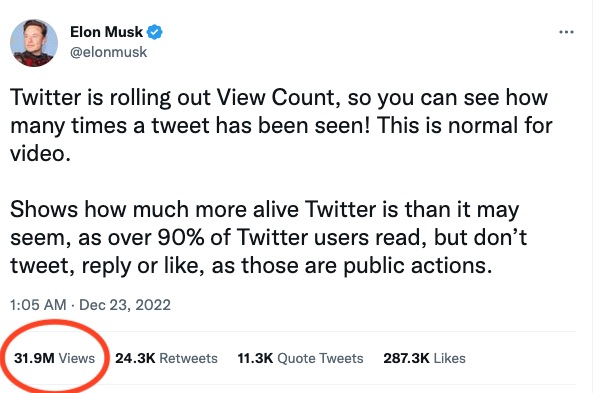Elon Musk has unveiled a new Twitter feature that lets you see how many times a tweet has been viewed.
The company’s new owner and CEO posted about the feature on Thursday, noting that it’s similar to how the platform already shows view counts for videos.
“Twitter is rolling out View Count, so you can see how many times a tweet has been seen! This is normal for video,” Musk said. “Shows how much more alive Twitter is than it may seem, as over 90% of Twitter users read, but don’t tweet, reply or like, as those are public actions.”
The count shows on Twitter for iOS, Android, and web, and as you can see from Musk’s tweet (above), appears at the bottom of each post, on the far left.
While it’s already possible to see data linked to your own tweets via the platform’s analytics tool, the view count is now available for everyone to see.
On the important question of what actually counts as a view, the company says on a new page in Twitter’s Help Center: “Anyone who views your tweet counts as a view, regardless of where they see your tweet (eg, Home, Search, Profiles, tweets embedded in articles, etc.) or whether or not they follow you. Even an author looking at their own tweet counts as a view.”
It adds: “Multiple views may be counted if you view a tweet more than once, but not all views are unique. For example, you could look at a tweet on the web and then on your phone, and that would count as two views.”
However, view counts won’t show for community tweets, Twitter Circle tweets, and “older” tweets, though Twitter doesn’t say how old.
Considering the mayhem caused by Musk since he acquired Twitter at the end of October, this new feature feels like the least controversial thing to have happened there in a while.
But it’s too early to say if things are starting to settle down at the company. First, Musk needs to install a new CEO since he has promised to honor the results of a Twitter poll that said he should step down from the role. The billionaire entrepreneur says he’s looking for someone to take the reins, but expressed concern that no one will be “foolish enough” to take on the challenging job.
Editors’ Recommendations
